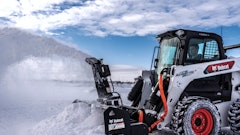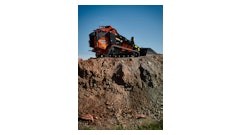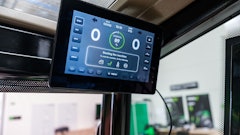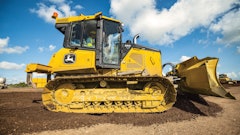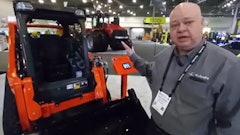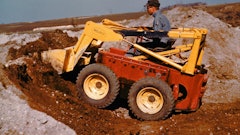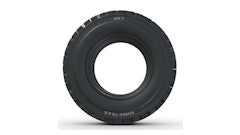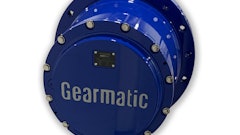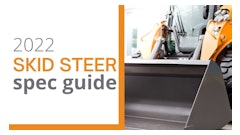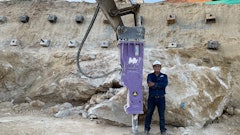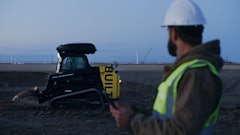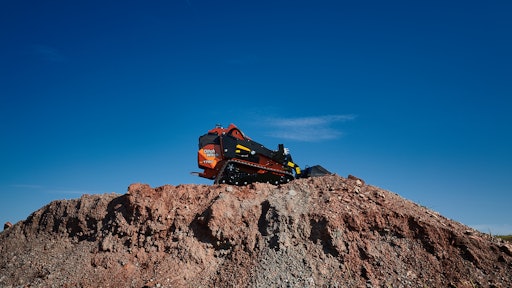
The popularity of skid steers is steadily rising, as more construction employees and jobsite managers and owners are becoming increasingly interested in them.
After all, their versatility—across a range of applications, from landscaping and material handling to roadwork and snow removal—is one reason for their popularity, according to Justin Moe, product manager, construction division, KIOTI.
“As the boom in acquisitions continues to increase and operators and jobsite owners consider which skid steers they should purchase, they need to first identify their spec needs,” he said. “The primary reasons are two-fold. First, skid steers’ specs will influence what they can do with each asset. And second, they have to understand their needs as they evaluate their machines.” KIOTI’s SL750 helps operators easily dump materials into trucks and high-sided hoppers.KIOTI
KIOTI’s SL750 helps operators easily dump materials into trucks and high-sided hoppers.KIOTI
While identifying their spec needs, lift capacity is one of the most significant aspects for operators to consider, according to Moe. Of equal importance, they must also consider variables like ground clearance, lift path, operating weight and productivity features.
“Additionally, operators should have a clear vision of their intended applications and jobsite terrain, which will determine the size of a respective skid steer, whether it is a bigger model with higher specs or a smaller option that will enable them to navigate tight spaces,” he said. “A clear vision will help operators identify which attachments are necessary, which, in turn, impacts their requirements for engine horsepower, hydraulic flow and size.”
Aside from specs, operators must consider the maintenance required to decide which new skid steer models they should add to their fleets—the more straightforward and minimal the maintenance, the better.
When looking at new skid steers, Brant Kukuk, compact equipment product manager, Ditch Witch, advises operators and owners to ask dealers to share information concerning daily maintenance, including the ways they can properly implement maintenance schedules. In doing this, they’ll be able to determine whether they can perform maintenance on a particular skid steer, according to a certain schedule.
“Some manufacturers, like Ditch Witch, offer skid steers with maintenance-free bearings, which means they don’t have any daily grease points, enabling operators to focus on other tasks, aside from maintenance,” Kukuk said.
Doug Clark, product manager, compact equipment, Wacker Neuson, agrees, adding that skid steers should also offer operators straightforward access. Further, they should use equipment that features parts they can effortlessly acquire. As a result of these two primary offerings, operators will be able to reduce their downtime considerably.
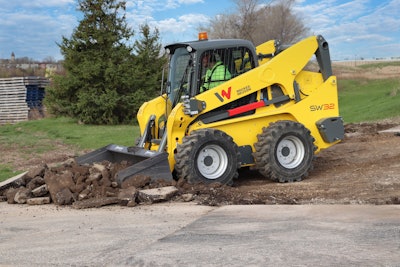 Aside from maintaining confidence during their maintenance checks, Wacker Neuson also ensures that operators implement maintenance before their skid steers have significant issues.Wacker Neuson
Aside from maintaining confidence during their maintenance checks, Wacker Neuson also ensures that operators implement maintenance before their skid steers have significant issues.Wacker Neuson
In addition to maintenance, operators should think about skid steers’ use cases and jobsite requirements. As an example, according to Kukuk, small stand-on skid steers are ideal for residential projects because they are compact enough to maneuver through gates while minimizing yard damage. Larger stand-on skid steers provide operators with the horsepower and weight they need to lift and move heavier loads across jobsites.
“Depending on the attachments operators are using, skid steers also have to be a certain size and weight, [to] counter loads,” he added.
Concerning horsepower, along with other engine components, Emily Pagura, solutions marketing manager, John Deere, believes it’s vital for operators and jobsite owners to purchase skid steers from manufacturers that have reliable engine histories. Competency, regarding emission regulations and components, should be fully considered, too.
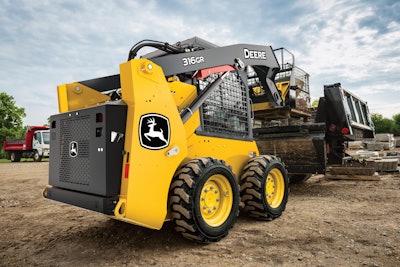 Every John Deere skid steer features a telematics solution, known as JDLink, which is offered free of charge.John Deere
Every John Deere skid steer features a telematics solution, known as JDLink, which is offered free of charge.John Deere
As operators choose a skid steer model, its hydraulic capability must match its attachments as well, according to Pagura. To ensure that this is the case, a skid steer’s hydraulic flow needs to be sufficient for an attachment’s requirements. A skid steer should also have a proper cooling capacity that guarantees that overheating is prevented.
“Features like an automatic reversing fan, which is offered on each John Deere skid steer, helps every offering maintain a proper cooling capacity, as engine debris build-up is mitigated, while excessive wear or damage, which would have otherwise occurred [because of] overheating, is also prevented,” she said.
Pagura adds that operators who work in environments with a considerable amount of debris may need additional protection kits installed on their skid steers, which will protect the skid steers and the operators.
“For applications associated with large debris, such as demolition, forestry and waste, it’s critical for operators to seek … these additional kits, which John Deere provides,” she said. “As a result, they’ll prevent downtime, due to skid steer damage, substantially.”
Technology Enhances Skid Steer Reliability
To offer contractors consistent reliability, particularly regarding operation and usability, Wacker Neuson’s skid steers’ forward tipping cabs enable them to rapidly access each of their machines’ components, even if their cabs’ loader arms are down. Such fast access is primarily a direct result of the skid steers’ layouts because they ensure that operators need less time whenever they’re conducting daily checkups.
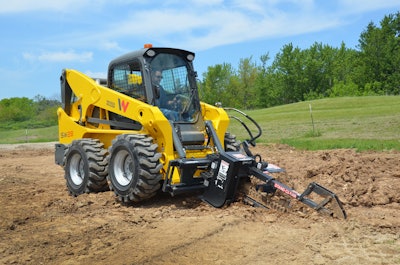 To provide operators with high reliability, Wacker Neuson’s skid steers have forward tipping cabs that allow teams to rapidly access components.Wacker Neuson
To provide operators with high reliability, Wacker Neuson’s skid steers have forward tipping cabs that allow teams to rapidly access components.Wacker Neuson
While focusing on enhancing operators’ skid steer reliability, Ditch Witch recently released its SK1750, which features an enhanced track design. Because of this enhanced track design, the skid steer offers operators a smooth, comfortable ride. In turn, it also provides high maneuverability and stability, regardless of load weights or topography throughout the transportation process. In fact, according to Kukuk, the SK1750 can even transport heavy loads across rough terrain.
“The track design causes less disturbance to the ground, allowing operators to work more efficiently and spend less time repairing damaged turf on residential jobsites,” Kukuk said. “Not to mention, as a result of its improved roller design, the SK1750’s reliability—along with operators’ jobsite productivity—is consistently high.”
KOTI’s SL750 was designed to lift, push and power through operators’ rigorous demands. Enabling operators to effortlessly dump their materials into trucks and high-sided hoppers consistently, the skid steer has a 10.5-foot height-to-hinge pin and vertical lift path, too.
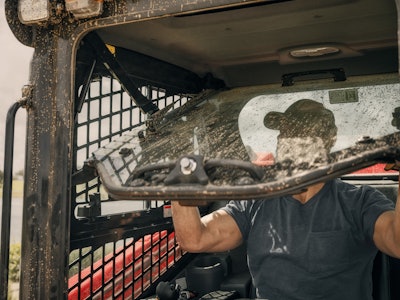 KIOTI’s SL750’s 74-horsepower diesel engine offers operators consistent power and reliability.KIOTI
KIOTI’s SL750’s 74-horsepower diesel engine offers operators consistent power and reliability.KIOTI
“Offering a wide cabin, which is available with a standard open-station design or an optional enclosed cab with heating, ventilation and air conditioning (HVAC) for additional comfort, the skid steer also has a standard roll-up-style door,” Moe said. “Due to this door, operators can easily enter or exit its cabin, resulting in further reliability, regarding its comfort and ease of use.”
John Deere has two offerings that will increase skid steers reliability, concerning operation and usability, too: the JDLink and the John Deere Operations Center. As John Deere’s telematics solution, JDLink feeds skid steer data into a centralized operations center that enables contractors and operators to monitor equipment and implement data-backed maintenance decisions.
By using JDLink and the Operations Center, contractors and those responsible for equipment maintenance can aggregate information, including diagnostic trouble codes, equipment and engine performance, locations and maintenance schedules. In doing so, they’ll be able to identify and address any potential issues before they escalate.
“With remote diagnostics and programming, dealers can access and reset diagnostic trouble codes, record machine information and update software entirely remotely,” Pagura said. “In some cases, this capability can prevent the need for a technician to visit an operator’s jobsite, thereby eliminating costs and waiting time.”
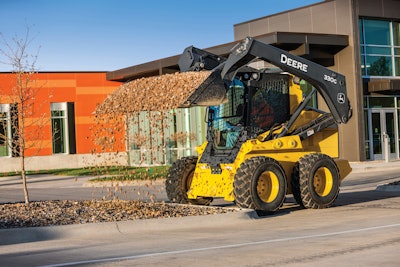 John Deere's skid steers allow operators to effortlessly and quickly access areas that require steady cleanout, inspections and maintenance, resulting in high reliability.John Deere
John Deere's skid steers allow operators to effortlessly and quickly access areas that require steady cleanout, inspections and maintenance, resulting in high reliability.John Deere
“In a matter of minutes, an operator or technician can raise the boom, enact the mechanical boom lock out from inside the cab and exit their skid steer,” Pagura said. “They can also access its dipstick, drivetrain and filters, along with its belly, where debris can be washed out—all from ground level.”
Technology Minimizes Skid Steer Maintenance
Along with offering high reliability, KIOTI’s SL750 also reduces operators’ maintenance requirements. In particular, the skid steer has a swing-out rear radiator that enables operators to easily reach common service items, simply by removing two bolts, according to Moe.
“The skid steer’s easy-to-lift cab and quick access to fittings and valves further simplify serviceability too,” he said. “And since it features easy-to-access hydraulic test ports for all major hydraulic components, the skid steer ensures operators can quickly conduct any troubleshooting as well.”
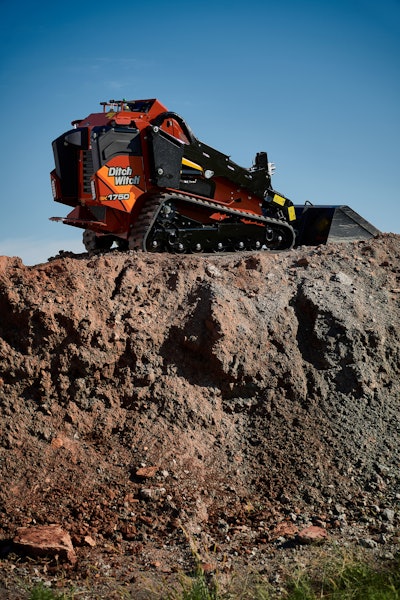 Ditch Witch's SK1750 provides operators with high maneuverability and stability, enabling them to transport heavy loads across rough terrain.Ditch Witch
Ditch Witch's SK1750 provides operators with high maneuverability and stability, enabling them to transport heavy loads across rough terrain.Ditch Witch
“Its window, in particular, allows operators to visually check track tension without ever having to thread a separate gauge tool,” Kukuk said. “Consequently, they’ll be able to save time, while also feeling confident in their routine maintenance checks.”
Aside from maintaining confidence during their maintenance checks, Wacker Neuson also ensures that teams implement maintenance before their skid steers ever have significant issues. To achieve this key goal, the manufacturer offers operators a telematics solution known as EQUIPCARE. By subscribing to this solution, operators, along with mechanics and owners, are alerted before any potential issues lead to damage, thus enabling their skid steers to receive … maintenance well before they shut down.
“The solution offers operators assistance with regular maintenance as well, as Wacker Neuson’s skid steers can alert anyone who has access to the solution whenever maintenance is [needed],” Clark said. “More than anything else, telematics can radically reduce the probability of downtime, as well as the length of it.”
Likewise, JDLink, along with the John Deere Operations Center, can help prevent operators’ needs for repairs because issues are identified and outcomes are predicted, leading to timely, cost-saving interventions, according to Pagura.
“One of the best ways to prevent the need for repairs is with regular preventive maintenance,” she said. “By purchasing a preventative maintenance plan from a John Deere dealer, operators can rest assured that their skid steers’ maintenance will always be conducted on time.”
While conducting maintenance, John Deere dealers constantly use high-quality fluids, parts and technicians. All fluids and parts can be purchased through a local John Deere dealer. Just as importantly, the manufacturer provides offerings like filter packs, which streamlines maintenance even further, as a single part number—which combines parts that are needed for 500-hour and 1,000-hour service intervals.
Reduce Mistakes Associated with Maintenance
While reflecting on the mistakes that generally occur as operators maintain their skid steers, Clark believes one part is especially correlated with errors: filters. Some maintenance teams often fail to properly follow their filter maintenance intervals. Sometimes, they fail to shorten the intervals when operating in harsh conditions, which includes being used in high temperatures or in areas that have high amounts of dirt and dust.
Additionally, operators may underestimate the value of pre-operation preventative maintenance checks and services, which can substantially increase the probability of a significant issue. To help prevent these mistakes, Clark advises operators to not only have a telematics package but also to implement standardized checklists, regularly scheduled sampling, maintenance plans and standard grease point routines.
“Basically, operators should plan to take care of their skid steers so that the skid steers will take care of them,” Clark said. “Operators must never get ‘too busy’ to oversee a pre-operation checklist either. ‘Once in a while’ can certainly become ‘most of the time’ before operators know it.”
Often, track rubber may separate from a stand-on skid steer’s track system because operators tend to forget about checking for tension while forgetting about surveying track rubber’s and rollers’ condition. To prevent these issues, operators must check their skid steers’ tracks for proper tension every day before use.
“This will be a different process depending on the model of each … skid steer, so operators should also consult their local dealers for support,” Kukuk said.
Teams should routinely clean their stand-on skid steer track systems to help prevent debris and dirt from entering their rollers and damaging them. Furthermore, by routinely cleaning their skid steer track systems, operators will minimize the likelihood of track rubber being worn down.
“Clean skid steers don’t just look better. [They] last longer as well,” Kukuk said. “To help keep track systems clean and issue-free, operators should wash them with a hose at least once a week or more, if necessary.”
 In addition, KIOTI’s SL750 has a 10.5-foot height-to-hinge pin and vertical lift path.KIOTI
In addition, KIOTI’s SL750 has a 10.5-foot height-to-hinge pin and vertical lift path.KIOTI
“Finally, operators should walk around their skid steers to check them for damage, enabling them to spot wear patterns and consistent use trends during operation,” Moe said. “They should also keep a record of any damages that are detected, no matter how minor they may seem.”
He added, “Proactivity, concerning any concerns or even minor damage, will go a long way as operators strive to maintain their skid steers’ health and operating capabilities for years to come.”
Pre-Operation Checklist
- Check air filters. All filters, including cab and engine air, must be checked for debris and dirt.
- Examine fluid levels. All fluid levels, including coolant, engine oil, fuel and hydraulic oil, must be examined to ensure that they’re within the required operating range in the owner’s manual.
- Inspect leaks. Teams must also inspect their skid steers for leaks or fluids that are pooling in the chassis, engine or on the ground.
- Proper greasing. In addition, operators or maintenance teams should ensure that their skid steers are properly greased, guaranteeing their components’ lifespans are more likely to increase.
- Track service intervals. KIOTI’s skid steer cabs have LCDs that allow operators to track and reset their service intervals so that they remain informed whenever their skid steers need to be serviced.







